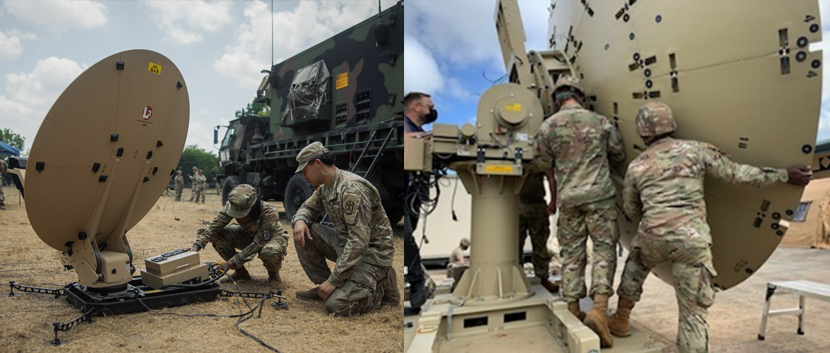
Tactical Network Transport-At The Halt (TNT-ATH) enables global command and control and robust voice, video, and data communications anywhere on the planet. TNT-ATH leverages a combination of high-capacity line-of-sight (radio) and beyond-line-of-sight (satellite) communications nodes for multipath diversity and resiliency in contested environments. These robust network communications systems operate at-the-halt and at-the-quick-halt (ATQH) and deliver the real-time data that commanders need to make rapid informed decisions.
To support expanding network requirements and improve the readiness of today’s operational force, the Army continues to modernize the TNT-ATH capability, improving deployability, mobility, computing power, and interoperability, while optimizing and increasing bandwidth and resiliency in congested and contested environments.
Network Node Capabilities
The current/legacy TNT-ATH portfolio contains three main transportable network nodes that provide high-speed wide area network capability for secure voice, video and data exchange. The Tactical Hub Node (THN) support division and above headquarters; the Joint Network Node (JNN) supports brigade and above headquarters; and the Command Post Node (CPN) supports battalion-level headquarters and smaller-sized units.
Product Manager Mission Network has been delivering the Network Integration Technology Enhancement (NITE) since fiscal year 2021 to refresh the Army’s widely fielded legacy JNN and CPN equipment, which is reaching end of life. The modular NITE solution provides a more than 200 percent increase in computing power, while reducing size, weight and power (SWaP) and equipment setup time for increased mobility. The equipment is also easier to operate and maintain. These benefits are derived from new commercial hardware, software and virtualization technologies. The new modular equipment is being deployed in transit cases with tow handles and wheels, and improves the current shelter solution, increasing maneuverability, commonality within the TNT-ATH portfolio and operational flexibility. NITE also reduces system power requirements, enabling the use of vehicle power for short-term ATQH operations.
NITE Modernization Re-designs: PdM Mission Network is accelerating efforts to redesign and field NITE TNT-ATH configurations to replace current systems in the ATH fleet. These new designs modernize the TNT-ATH baseline even further and will significantly reduce SWaP-Cost and Soldier burden, while increasing simplicity, network security and resiliency, operational flexibility, maneuverability and command post survivability. The redesigns improve commonality across TNT-ATH and On-The-Move systems. They also support the integration of future emerging technologies and convergence into PM Tactical Network’s innovative Satellite Communications (SATCOM) Family of Terminals (FoT) and Unified Baseband acquisition approaches.
- Medium Communications Node-Tactical (MCN-T) – replaces the CPN: The smaller more capable MCN-T was fielded to the first unit in September 2023. MCN-T reduces the number of computing stacks from three to two through the use of the Unified Unclassified Enclave (U2E). For fast at-the quick-halt operations, Soldiers can simply pull over to the side of the road during convoys or relocating the command posts and rapidly power up their MCN-Ts in the back of a vehicle using vehicle power and a cable, versus having to set up a separate generator. MCN-T modernizes the TNT-ATH baseline to support future emerging technologies and convergence with the Scalable Network Node (SNN) toward a Unified Baseband.
- Large Communications Node-Tactical (LCN-T) – replaces the JNN: On the current timeline, PdM Mission Network expects to begin fielding LCN-T to brigade and division headquarters in FY26. LCN-T is a smaller version of the JNN with a new shelter that can be integrated onto a Joint Light Tactical Vehicle (JLTV), which will eventually replace the Army’s fleet of Humvees. LCN-T is a two-man lift transit case solution and will also use the U2E, enabling the reduction of kit, shelter and number of system configurations. Since LCN-T will be transit case-based, units can deploy the system without the shelter as needed for additional operational flexibility on different maneuver platforms, and the setup/tear down times will be reduced for rapid maneuverability.
SATCOM Capabilities
Current/Legacy Satellite Transportable Terminals (STTs) operate in conjunction with JNNs and CPNs. These satellite terminals are designed to establish secure voice, video and data communications virtually anytime and anywhere. Future modernized capability will be known as the Large Deployable Terminal (LDT) and will be part of the SATCOM Family of Terminals.
Scalable Network Nodes (SNNs) -- support Expeditionary Signal Battalion-Enhanced (ESB-E) and other expeditionary formations and replaces all of its legacy JNN, CPN, STT, and Single Shelter Switch (SSS) equipment items within a formation with a single equipment kit. As part of the Army’s network modernization efforts and Family of SATCOM Terminals approach, the SNN provides a significant reduction in the footprint requirements of an ESB-E. The smaller footprint of the SNN and reduced complexity of the kit has enabled modernized ESB-E formations to significantly increase their Command Post support, while reducing transportation requirements by over 60 percent. The SNN can be setup in minutes, and each SNN can immediately begin to support operations using an included 2kW generator until the support unit is able to provide increased power.
Extra Large Deployable Terminal (XLDT) -- replaces the THN: As part of the SATCOM Family of Terminals, Project Manager Tactical Network will modernize the current THN design, which consists of the Unit Hub Node (baseband) and the Unit Hub Satellite Truck. The modernization effort will result in a multi-band beyond-line-of-sight capability for division-level units and above, with a sizable reduction in SWaP and significant improvements in modularity and transportability.